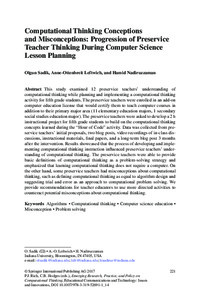Computational Thinking Conceptions and MisconceptionsProgression of Preservice Teacher Thinking During Computer Science Lesson Planning
Olgun Sadik, Anne-Ottenbreit Leftwich, Hamid Nadiruzzaman
Zu finden in: Emerging Research, Practice, and Policy on Computational Thinking (Seite 221 bis 238), 2017
  |
 |
 Diese Seite wurde seit 3 Jahren inhaltlich nicht mehr aktualisiert.
Unter Umständen ist sie nicht mehr aktuell.
Diese Seite wurde seit 3 Jahren inhaltlich nicht mehr aktualisiert.
Unter Umständen ist sie nicht mehr aktuell.
 Zusammenfassungen
Zusammenfassungen

This study examined 12 preservice teachers´ understanding of computational thinking while planning and implementing a computational thinking activity for fifth grade students. The preservice teachers were enrolled in an add-on computer education license that would certify them to teach computer courses in addition to their primary major area (11 elementary education majors, 1 secondary social studies education major). The preservice teachers were asked to develop a 2 h instructional project for fifth grade students to build on the computational thinking concepts learned during the 'Hour of Code†activity. Data was collected from preservice teachers´ initial proposals, two blog posts, video recordings of in-class discussions, instructional materials, final papers, and a long-term blog post 3 months after the intervention. Results showcased that the process of developing and implementing computational thinking instruction influenced preservice teachers´ understanding of computational thinking. The preservice teachers were able to provide basic definitions of computational thinking as a problem-solving strategy and emphasized that learning computational thinking does not require a computer. On the other hand, some preservice teachers had misconceptions about computational thinking, such as defining computational thinking as equal to algorithm design and suggesting trial and error as an approach to computational problem solving. We provide recommendations for teacher educators to use more directed activities to counteract potential misconceptions about computational thinking.
 Dieses Kapitel erwähnt ...
Dieses Kapitel erwähnt ...
 Personen KB IB clear | Marina Umaschi Bers , Louise P. Flannery , George H. L. Fletcher , Idit Harel , David H. Jonassen , Elizabeth R. Kazakoff , Jeff Kramer , James J. Lu , Seymour Papert , Jeannette M. Wing | |||||||||||||||||||||||||||||||||||||||||||||||||||||||||||||||
 Begriffe KB IB clear | computational thinkingcomputational thinking
,  Denken Denken thinking
, Informatikcomputer science
, thinking
, Informatikcomputer science
,  LehrerIn LehrerIn teacher
, LehrerInnen-Bildungteacher training
, notional machine
, teacher
, LehrerInnen-Bildungteacher training
, notional machine
,  Ozobot
, Ozobot
,  Problemlösefähigkeit Problemlösefähigkeit problem solving skills
, Versuch und Irrtumtrial and error problem solving skills
, Versuch und Irrtumtrial and error
| |||||||||||||||||||||||||||||||||||||||||||||||||||||||||||||||
 Bücher |
| |||||||||||||||||||||||||||||||||||||||||||||||||||||||||||||||
 Texte |
|
 Dieses Kapitel erwähnt vermutlich nicht ...
Dieses Kapitel erwähnt vermutlich nicht ... 
 Nicht erwähnte Begriffe | Informatik-Didaktik, Informatik-Unterricht (Fachinformatik), Schule, Unterricht |
 Tagcloud
Tagcloud
 Zitationsgraph
Zitationsgraph
 Zitationsgraph (Beta-Test mit vis.js)
Zitationsgraph (Beta-Test mit vis.js)
 Anderswo finden
Anderswo finden
 Volltext dieses Dokuments
Volltext dieses Dokuments
 |  Computational Thinking Conceptions and Misconceptions: Progression of Preservice Teacher Thinking During Computer Science Lesson Planning: Artikel als Volltext bei Springerlink ( Computational Thinking Conceptions and Misconceptions: Progression of Preservice Teacher Thinking During Computer Science Lesson Planning: Artikel als Volltext bei Springerlink ( : :  , 283 kByte; , 283 kByte;  : :  ) ) |
 Anderswo suchen
Anderswo suchen 
 Beat und dieses Kapitel
Beat und dieses Kapitel
Beat hat Dieses Kapitel während seiner Zeit am Institut für Medien und Schule (IMS) ins Biblionetz aufgenommen. Beat besitzt kein physisches, aber ein digitales Exemplar. Eine digitale Version ist auf dem Internet verfügbar (s.o.). Es gibt bisher nur wenige Objekte im Biblionetz, die dieses Werk zitieren.















 Biblionetz-History
Biblionetz-History